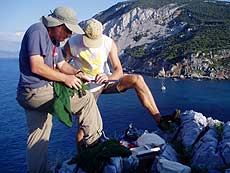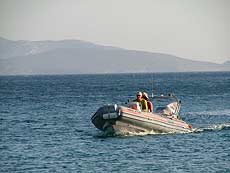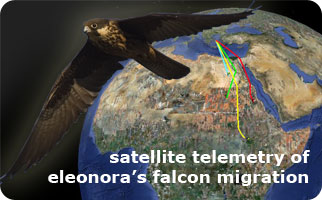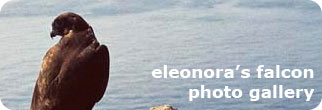Continuation of the census and monitoring actions for Eleonora’s Falcon in the Aegean Sea for 2005
 For a second consecutive year the HOS was present and active on the islands and islets of the Aegean Sea, well known areas not only for the Eleonora’s Falcon, but also for the experienced staff of the HOS, that had undertaken the mission of completing the census of the species in Greece as well as monitoring its breeding performance in selected colonies (within the context of the LIFE – Nature project).
For a second consecutive year the HOS was present and active on the islands and islets of the Aegean Sea, well known areas not only for the Eleonora’s Falcon, but also for the experienced staff of the HOS, that had undertaken the mission of completing the census of the species in Greece as well as monitoring its breeding performance in selected colonies (within the context of the LIFE – Nature project).
It appears that our prayers for calm seas in August and September this year were answered, since the HOS field teams managed to complete the census of all the colonies in the Cyclades, the Dodecanese, the North Aegean, the Sporades, the Ionian Sea and the islets of the Karpathian Sea that were not covered during 2004. The results were very impressive and at the end of this year’s census, a total of 90 to 95% of the species distribution in Greece was covered.
Though the processing and evaluation of the collected data is still in progress, the first estimations indicate incontestably that Greece is the most important country for the breeding of Eleonora’s Falcon worldwide. It once again points out the importance of the Aegean Sea as a migration passage, due to its innumerable islets that constitute significant intermediate migratory stops for many passerines, on which Eleonora’s Falcon nestlings feed.
 Once again should be mentioned, the indispensable contribution, help and support of 60 volunteers, Greek and foreign, that manned this year’s field missions. The cooperation of the volunteers with the field ornithologists of the project all over the Aegean, was stressing the importance of volunteer work, especially when it is combined with knowledge, responsible attitude towards the protection and conservation of nature, spirit of collaboration and good mood. The case of our Spanish and English friends illustrates that, since they had a vast experience of similar actions in their countries and thus they could significantly contribute to the census work, as well as, in monitoring the breeding performance of the Eleonora’s Falcon by ringing of nestlings, collection of morphometric data and the collection of pellets and prey remains.
Once again should be mentioned, the indispensable contribution, help and support of 60 volunteers, Greek and foreign, that manned this year’s field missions. The cooperation of the volunteers with the field ornithologists of the project all over the Aegean, was stressing the importance of volunteer work, especially when it is combined with knowledge, responsible attitude towards the protection and conservation of nature, spirit of collaboration and good mood. The case of our Spanish and English friends illustrates that, since they had a vast experience of similar actions in their countries and thus they could significantly contribute to the census work, as well as, in monitoring the breeding performance of the Eleonora’s Falcon by ringing of nestlings, collection of morphometric data and the collection of pellets and prey remains.










